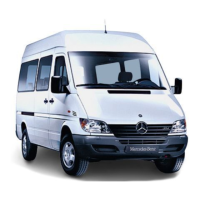Step 3
Example 1 Example 2
Permissible load (maximum
g
ross vehicle weight rating from
the Tire and Loading Information
placard minus the gross weight
of all occupants)
1500 lbs (680 kg) Ò 750 lbs
(340 kg) = 750 lbs (340 kg)
1500 lbs (680 kg) Ò 200 lbs
(91 kg) = 1300 lbs (589 kg)
Tire labeling
Overview of tire labeling
1
Uniform Tire Quality Grading Standards
(/ pag
e 253)
2
DOT (Department of Transportation), (TIN) Tire
Identication Number
(/ page 254)
3
Maximum tire load (/ pag
e 254)
4
Maximum tire pressure (/ pag
e 255)
5
Manufacturer
6
Characteristics of the tire (/ pag
e 255)
7
Tire size designation, load-bearing capacity
and speed r
ating (/ page 255)
8
Tire name
%
The data shown in the illustration is sample
dat
a.
Information on tire quality grades
According to the requirements of the U.S. Depart-
ment of T
ransportation's "Uniform Tire Quality
Grading Standards" tire manufacturers must grade
their tires using the following three performance
factors:
1
Tread wear grade
2
Traction grade
3
Temperature grade
%
The data shown in the illustration is sample
dat
a.
%
This grading is not legally prescribed for Can-
ada, but specied in mos
t cases anyway.
Tread wear grade
The tr
ead wear grade is a comparative grading
based on tread wear grade tests conducted under
controlled conditions on a specied U.S. Depart-
ment of Transportation test track. For example, a
tire graded 150 would wear one and one-half times
as well on the government test track as a tire gra-
ded 100.
The relative performance of tires depends upon
the actual conditions of their use, however, and
may depart signicantly from the norm due to var-
iations in driving habits, service practices and dif-
ferences in road characteristics and climate condi-
tions.
Traction grade
&
DANGER Risk of accident due t
o inade-
quate traction
The traction grade assigned to this tire is
based on s
traight-ahead braking traction tests.
#
Always adapt your driving style and drive
at a speed t
o suit the prevailing trac
and weather conditions.
Wheels and tires
253

